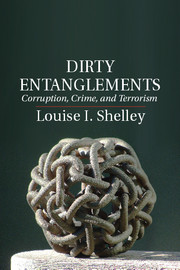Book contents
- Frontmatter
- Dedication
- Contents
- Figure, Maps, and Tables
- Acknowledgments
- Introduction
- Part I The Logic of Corruption, Crime, and Terrorism
- Part II The Diverse Businesses of Terrorism
- 5 The Business of Terrorism and Criminal Financing of Terrorism
- 6 The Drug Trade
- 7 The Less Policed Illicit Trade
- 8 Ultimate Fears
- Conclusion
- Index
- References
7 - The Less Policed Illicit Trade
Antiquities, Counterfeits, and Diverted Products
Published online by Cambridge University Press: 05 August 2014
- Frontmatter
- Dedication
- Contents
- Figure, Maps, and Tables
- Acknowledgments
- Introduction
- Part I The Logic of Corruption, Crime, and Terrorism
- Part II The Diverse Businesses of Terrorism
- 5 The Business of Terrorism and Criminal Financing of Terrorism
- 6 The Drug Trade
- 7 The Less Policed Illicit Trade
- 8 Ultimate Fears
- Conclusion
- Index
- References
Summary
Blood Antiques, a fascinating documentary produced by specialists on the illicit art trade, commences with an interview of a high-end Brussels art dealer using an undercover camera. The dealer frankly states, “All these pieces were looted in Afghanistan, every object which comes from Afghanistan is by definition stolen, if you have a problem with that…but you cannot buy better.” Many wealthy buyers do not care that their purchases fund terrorism; they choose not to investigate too closely the origins of the art they acquire.
Ancient tombs have been looted by the Taliban, and houses are raided by Taliban members looking for antiquities that can be sent abroad to fund their activities. These antiquities arrive in Paris, Brussels, and the United States, having been shipped from Pakistan, after poorly paid Afghan customs officials were bribed to look the other way. Law enforcement in the West does not address the problem effectively. As one officer in the firm called in to inspect a suspicious shipment explains, “I can hardly be expected to know all about the art history of the world.” As a result, Blood Antiques reveals that Brussels, the site of European Union and NATO headquarters, is packed with Taliban-supplied Afghan contraband. The chance of any of the facilitators of this high-end trade being caught is minimal, as very little attention is allocated by European law enforcement to the policing of art markets. Even if perpetrators are caught, the chance of serious punishment is negligible. Hence the sale of these exquisite antiques is a high-profit, low-risk crime for terrorists and criminals.
- Type
- Chapter
- Information
- Dirty EntanglementsCorruption, Crime, and Terrorism, pp. 259 - 288Publisher: Cambridge University PressPrint publication year: 2014



